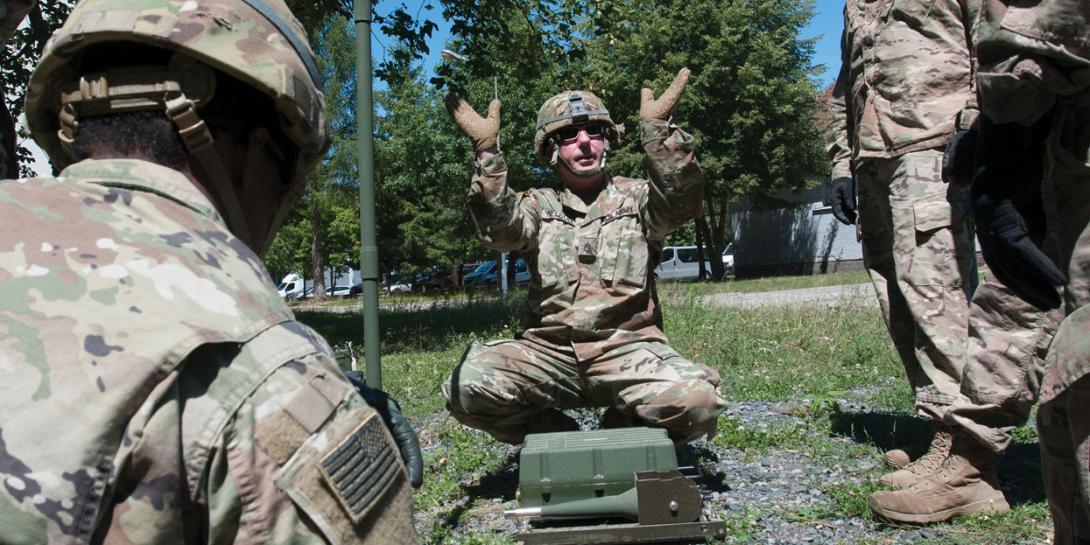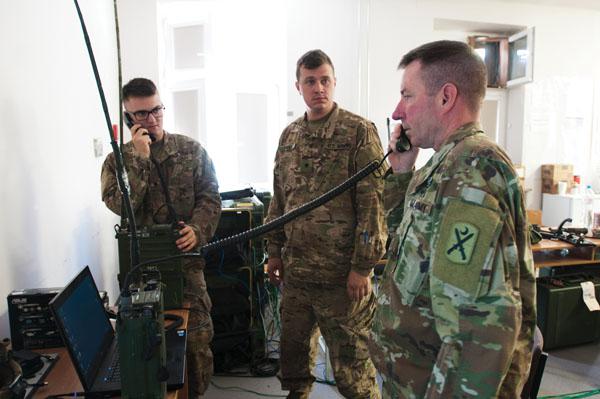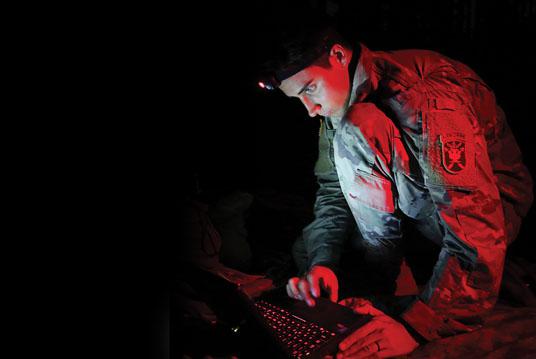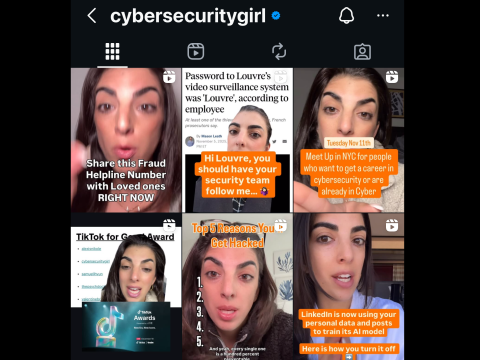High Frequency Communications Features Highs and Lows
As cyber threats continue to grow, so does the reality that digital satellite communications can be degraded and denied either through digital or electromagnetic means. If these capabilities are compromised, however, high frequency radio provides a means to continue communicating even beyond the line of sight by leveraging the ionosphere to refract radio signals back to earth.
The International Communication Union Telecommunication Standardization Sector designates the high frequency (HF) range as between 3 megahertz and 30 megahertz. While this method of communication was utilized extensively up through the 1990s, it began to lose traction in the military when the availability of satellite communications (SATCOM) increased.
Among the key differences between HF, very high frequency (VHF) and ultrahigh frequency (UHF) are the multiple antenna configurations required to radiate the signal properly in HF and the atmospheric conditions that greatly affect the propagation of the signal. In addition, choosing the correct frequency for the time of day plays a crucial role in setting up HF communications. Under these conditions and given the proper setup, HF radio signals can be targeted to a geographical region, enabling beyond line-of-sight communication without using satellites.
The growing dependency on SATCOM presents a problem: Because warfighters have been training for SATCOM, the training for effectively employing HF radio has dwindled; radios in the VHF and UHF range have continued to be used for line-of-sight communications.
According to Ronald C. Wilgenbusch and Alan Heisig in an article in Joint Force Quarterly, HF is not a viable option to SATCOM, and they agree the declining amount of training is an issue. “The worldwide system of fixed HF transmitters and antennas that was once the mainstay of our HF communications systems is gone. … Even if it was still in place, the skilled HF operators needed aboard ships and ashore have been cashing retirement checks for years,” they said.
Although the windfall of baby boomer retirements is challenging all government and commercial sectors, it has been especially hard on the computer industry. However, even though many HF-trained military members are separating from the services, a younger generation of enthusiasts is coming from the intersection of do-it-yourself aficionados and hackers. They are tinkering and creating small electronic devices, often using software-defined radios in their projects. They also are exploring various radio frequency-HF communication techniques and developing new hybrid skills.
Even the National Natural Science Foundation of China concluded that HF radio use will lead to self-adaptability and an ever-changing environment. HF radio use also will encourage and leverage machine learning approaches, which will result in the development of smart anti-jamming techniques and equipment. In addition, foundation members believe heterogeneous networking—a combination of HF communications and satellite communications, military networks and civil cellular communications—will enable an integrated space-air-marine-ground communication network.
HF communication using digital modes like FT8 is an example of how techniques evolve with digital communications. The ham and hacker communities have stated that evolving methods could enhance global communications while improving the use of limited spectrum.
There is a trade-off, however. HF data rates are far lower than SATCOM data rates. Consequently, a backup plan must not only detail how to utilize HF transmissions but also outline what data should be transmitted.
For example, it may not be possible to transmit the 2-megabyte battle brief of a PowerPoint slideshow using HF radio; however, the text from the slides could be transmitted without graphics over HF radio. In addition to bandwidth constraints, directing an HF signal to a specific location requires attention to many factors, including frequency, antenna configuration and power.
Using HF radios for communication also poses other challenges that require process and equipment planning. For example, HF radio communications at shorter distances where the environment obstructs line of sight is possible with near vertical incidence skywave (NVIS) propagation. The government communications uses NVIS and has a skywave radio-wave propagation that provides usable signals at distances of up to 400 miles.
The Army Cyber Institute, West Point, New York, recently conducted HF NVIS testing at the National Training Center in Fort Irwin, California. The test included the software JS8Call, the open source program WSJT-X and single sideband modulation voice communication.
To guarantee the propagation was true NVIS, the institute’s team placed stations on either side of Tiefort Mountain and verified that VHF communication was not possible. The team then utilized results from Voice of America Coverage Analysis Program prediction software to determine the proper frequency for the time of day and used a sloped dipole antenna configuration for the NVIS link. The voice link was easily established utilizing 50 watts of power.
Finally, the institute’s team tested WSJT-X to validate FT8 digital communication, which worked as expected, and used JS8Call to send messages, which reduced power consumption considerably and continued to receive JS8Call messages flawlessly.
HF NVIS has been called a “safety net under our infrastructure” that serves as the base layer national fallback network for regional and wide area communications for government, industry, public safety and critical infrastructure when primary systems fail. Initiatives like HF NVIS enable communications resilience and situational awareness within critical infrastructure defense during catastrophic events such as natural disasters, cyber attacks or electromagnetic pulse attacks.
The U.S. Department of Homeland Security Cybersecurity and Infrastructure Agency SHAred RESources (SHARES) HF Radio Program is one example of this safety net. SHARES provides a 24-hour capability to provide an emergency communications link to support intra- or interagency mission requirements.
Col. Stephen Hamilton, USA, is a cyber officer who currently is the technical director of the Army Cyber Institute. Chief Warrant Officer 4 Judy M. Esquibel, USA, is a cyber operations technician and doctoral student in the Department of Information Sciences, Naval Postgraduate School, Monterey, California, and an Army Cyber Institute Fellow.
You may also enjoy:







Comment
Great article on HF comms.
Great article on HF comms. Yes, Ham radio has been using digital modes for quite some time and fun as well. We often talked in the comm shack about losing experts in the HF arena when the Navy went to more SATCOM use. In my younger years we practiced HF comms regularly. We need to think out of the box and push this training back into our various curriculums.
Very interesting article. I
Very interesting article. I fear Wilgenbusch and Heisig have over-stated the death of HF, however, in a changing threat environment. HF communications can't keep up, from a data-rate perspective to higher-frequency applications where available bandwidth is also much greater, but this argues, to some extent, that the bell-and-whistle quotient is getting too high on our communications requirements.
In cloud computing, we've learned that retrieving the results of a large computational run can be very expensive, but if the data are post-processed in the Cloud, and solely the results from your post-processed data, generally the volume and thus cost savings can be effected. In this regard, we need to identify what elements of digital communications are vital for the types of data we're talking about sending around, and optimize the data flows rather than thinking we've unlimited bandwidth.
As a retired Irish Army Sig
As a retired Irish Army Sig Corps Capt. this is a great article, like a breath of fresh air. It brings it all back from the 1950s. Is CW and morse code part of the future ? There was no mention of the sun-spot activity charts.
I'm not sure we'll ever
I'm not sure we'll ever revive CW as a viable communications mode. However, investing in JT8 and the like gets us the benefit of the better SNR recovery while allowing use of computers to recover the data.
Gerry--Absolutely--we've done
Gerry--Absolutely--we've done some testing with JT8 at NTC, and it performed phenomenally well! We did a NVIS shot at < 1 watt, and I was very impressed.
Stephen, I'd like to learn
Stephen, I'd like to learn more. I'll reach out. Joe's done some real good work on relatively low bandwidth, small signal spectrum-diverse comms that we all need to pay attention to.
Thanks! Actually sun spot
Thanks! Actually sun spot activity is a little bit of a depressing topic in my mind, as we are headed for a solar minimum, and no one really knows how bad it will get. Good news is for the next 5-6 years we are on the cycle upswing, and I'm seeing some promising propagation happening!
NVIS - HF is used every day
NVIS - HF is used every day by EMCOM agencies, and it works as advertised.
When I was in the Marines at
When I was in the Marines at 9th Comm Bn, we utilized HF assets heavily. Along with that, we took advantage of the capabilities of NVIS antenna design. One such antenna should be brought back into use is the AS2259GR, because of versatility.
Craig, DX Engineering
Craig, DX Engineering (dxengineering.com) has a product similar to the AS2259GR and it does work well. I've used it on Civil Air Patrol exercises successfully. Mine was constructed from dimensions available on-line, with a few liberties taken because the central coaxial element isn't available (mine is simply RG8X fed without a BALUN. I need to put it on the network analyzer but it was a good performer in the NVIS range to about 250 miles.
Comments